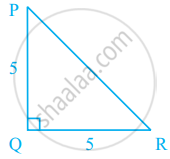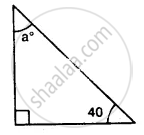Advertisements
Advertisements
प्रश्न
In figure, PQ ⊥ RQ, PQ = 5 cm and QR = 5 cm. Then ∆PQR is ______.
विकल्प
A right triangle but not isosceles
An isosceles right triangle
Isosceles but not a right triangle
Neither isosceles nor right triangle
उत्तर
In figure, PQ ⊥ RQ, PQ = 5 cm and QR = 5 cm. Then ∆PQR is an isosceles right triangle.
Explanation:
Since, PQ Perpendicular to RQ
So, ∆PQR = 90°
∴ ∆PQR is right-angled triangle.
Also, in ΔPQR,
PQ = QR
ΔPQR is an isosceles triangle.
APPEARS IN
संबंधित प्रश्न
The angles of a triangle are arranged in ascending order of magnitude. If the difference
between two consecutive angles is 10°, find the three angles.
If the bisector of the exterior vertical angle of a triangle be parallel to the base. Show that the triangle is isosce
AB is a line segment. P and Q are points on opposite sides of AB such that each of them is equidistant from the points A and B (See Fig. 10.26). Show that the line PQ is perpendicular bisector of AB.

Is the following statement true and false :
Sum of the three angles of a triangle is 180 .
In ΔABC, if bisectors of ∠ABC and ∠ACB intersect at O at angle of 120°, then find the measure of ∠A.
If the side BC of ΔABC is produced on both sides, then write the difference between the sum of the exterior angles so formed and ∠A.
In ΔPQR, If ∠R > ∠Q then ______.
State, if the triangle is possible with the following angles :
40°, 130°, and 20°
Calculate the unknown marked angles of the following figure :

One of the base angles of an isosceles triangle is 52°. Find its angle of the vertex.
